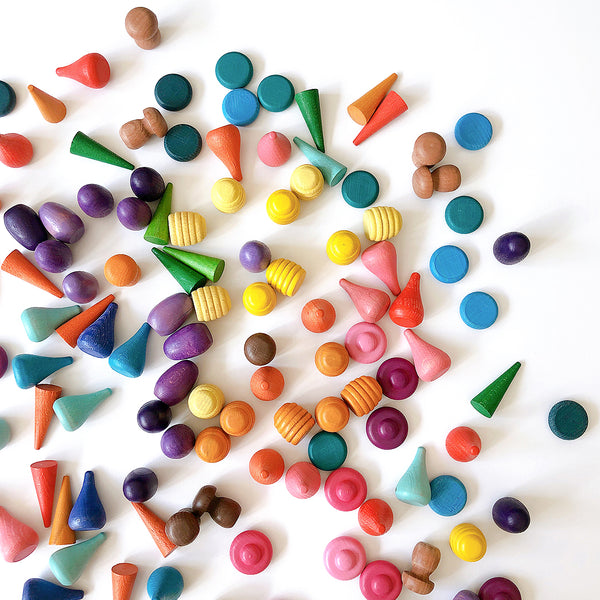
Math is all around us, it's the most relevant to life and we use it in everyday language - sometimes without us even realising. How many biscuits have you had? 2 minutes from now, half a cup left, how far is it? Are all natural and simple math based questions we expose our kids to on a daily basis. As they are absorbing all these words and meanings, they too are naturally understanding different math concepts.
Introducing math and numbers to children doesn’t have to be boring or rote learned; it should be taught in a fun and interactive way that stimulates creative play and thinking. Using loose parts in simple math play activities can help kick-start an enjoyment of learning math for kids without them even realising it!
Here are just a few simple but fun ideas to challenge your kids to use loose parts to explore numbers and math concepts:
1. Counting and Number Recognition
Reading, writing and recognising numbers is an important part of mathematics. Depending on how old your child is - ask them to use loose parts to form the shape of a number, or trace an outline of a number that you have provided. This is a great way to build number identification and can help with writing later on.
Another way I use loose parts for Miss A (2 years), is to provide her with a visual of a number and then I ask her to count and add the corresponding pieces of loose parts. This activity encourages little ones to understand the concept behind each number while helping them improve their counting skills.


2. Measurements
Line some loose parts up in rows and make them different lengths. Ask your child which is longer and/or shorter? How many loose parts were used? What's the difference?
Get your child to go around the house and find simple objects they can use, and ‘measure’ them with loose parts. Talk about what they find - which one uses up more loose parts? Which one is shorter or longer?
These interactive activities can help encourage learning of subtraction and addition in a more spontaneous and inquisitive manner.
3. Pattern Play
Encourage your child to explore the loose parts and just have fun lining them up in a row, or creating other fun shapes they come up with. You could also try making patterns and ask your child to fill in what comes next.

4. Learning Shapes
Once again, depending on how old your child is, they may be able to draw their own shape and use loose parts to trace over. Alternatively, guide your child as you ask them to make different shapes with the loose parts. You may need to show them how to do it, and then ask them to follow you. This will teach them how to better manipulate the loose parts and can help in shape recognition and draining later on.

5. More or Less
Get your child to sort a small bunch of loose parts based on the same colours and/or shapes. Ask them questions like which group is bigger and which is smaller? How many in this group? How many more/less in the other?
Another activity you could try is to fill up two bowls with different amounts of loose parts and get your child to guess which one has more. Then, get them to count and see if they were right!

These are just a few ways you could incorporate loose parts to encourage counting and math play. What we love is that loose parts don’t need to be fancy, you can use anything!
Get out with your child for a nature walk and pick up some rocks, sticks, twigs, leaves and use those in your play. Or if you’re homebound, gather some bottle caps, dried beans, buttons or even dried pasta and watch your child have a fun time learning while they play.

Leave a comment